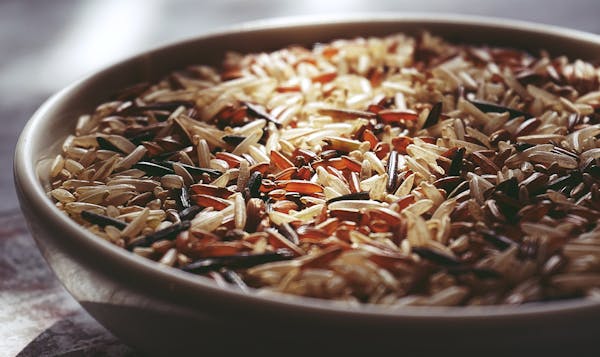Savor Belém: The Flavor of Pará Rice.
Imagine rice infused with the Amazon's golden secret: tucupi. Explore the captivating flavors and potential health benefits of this Pará culinary gem.
HEALTHY DISHES
CILZA DUARTE
4/20/20256 min read


Pará-style Rice: Shrimp & Tucupi -The Heart of Cuisine.
Steam rose from the pot as I added the golden tucupi—that mesmerizing extract of wild manioc—to the simmering rice. The kitchen instantly filled with an aroma that transported me straight to the heart of the Amazon. This wasn't ordinary rice preparation; it was an initiation into one of the most captivating yet underappreciated culinary traditions on the planet. (And I've explored enough global cuisines to recognize when something extraordinary is taking form.)
Have you ever wondered what might happen if the boundless Amazon rainforest and the storied Mediterranean coastlines somehow merged their nutritional wisdom on a single plate? That's the magic of Pará-style rice—Brazil's hidden health powerhouse that deserves global recognition alongside the world's most celebrated healthy cuisines.
When Two Worlds Collide: Amazon Meets Mediterranean
The health world remains captivated by Mediterranean diets. Olive oil this, whole grains that. The endless stream of Mediterranean cooking shows and recipe collections continues unabated.
But what if I told you that nestled in Brazil's northern Pará region exists a rice preparation that rivals—and in some nutritional dimensions, even surpasses—the celebrated Mediterranean approach?
Pará-style rice, this brilliant creation born from indigenous wisdom and regional biodiversity, begins with the foundation of humble rice grains. But what transforms this everyday staple into something extraordinary is its marriage with tucupi—the fermented yellow liquid extracted from wild manioc—and jambu, an Amazonian herb that creates a gentle tingling sensation on the palate. When fresh shrimp and aromatic herbs join this ensemble, something truly remarkable emerges.
This thoughtful preparation isn't merely cooking—it's nutritional alchemy where seemingly simple ingredients combine to create a dish with profound benefits. This mirrors the Mediterranean principle of transforming basic ingredients into foods with exceptional health properties.
The Nutritional Powerhouse You've Never Heard Of
Let's don our nutritional detective hats for a moment.
Mediterranean diets shine through their balance of complex carbohydrates, quality proteins, and bioactive plant compounds. Pará-style rice delivers this exact same trifecta through an entirely different ecosystem of ingredients.
The nutritional profile of authentic Pará-style rice is truly impressive:
Rice providing complex carbohydrates for sustained energy release
Tucupi offering unique bioactive compounds and beneficial acids
Jambu contributing anti-inflammatory properties and micronutrients
Shrimp delivering complete protein with all essential amino acids
Fresh herbs providing vitamins and antioxidant compounds
Na verdade, pensando melhor, the bioactive composition in tucupi is particularly fascinating. While Mediterranean diets often rely on olive oil and wine for their phenolic compounds, tucupi's fermentation process creates unique organic acids and bioactive elements that some preliminary research suggests may have comparable antioxidant effects through entirely different biochemical pathways.
"Tu já provaste arroz paraense?" The Cultural Context
"Have you tried Pará-style rice yet?" This question often welcomes curious visitors to authentic kitchens throughout Pará. Much like how Mediterranean communities gather around shared paella or risotto, Pará-style rice brings people together.
It regularly appears during community celebrations and family gatherings, where its distinctive preparation becomes an expression of regional identity and shared heritage. This connection between food and communal experience mirrors the Mediterranean approach to dining—where meals transcend nutrition to become vehicles for connection and cultural continuity.
I once watched a family in Belém prepare their special rice for a weekend gathering. "Deixe o tucupi cantar," the cook advised as she added the golden liquid to the pan—"let the tucupi sing"—a poetic reminder that some ingredients need time to fully express their character. The pride in preserving this tradition was unmistakable.
The Science Behind the Superfood
What truly connects Pará-style rice to the Mediterranean diet isn't just cultural similarities—it's the underlying nutritional science.
Both dietary approaches feature:
Complex carbohydrates that provide sustained energy without dramatic blood sugar fluctuations
Complete proteins that deliver essential amino acids through seafood
Bioactive plant compounds with antioxidant and anti-inflammatory properties
A complementary nutrient profile where each ingredient enhances the bioavailability of nutrients in others
The jambu in Pará-style rice provides not just flavor but also unique alkaloids like spilanthol that some preliminary research suggests may have analgesic and anti-inflammatory benefits comparable to some elements in the Mediterranean diet.
Mediterranean diets are celebrated for their cardiovascular benefits. Early research indicates that the unique combination of tucupi's bioactive compounds, jambu's alkaloids, and the complete amino acid profile from shrimp may offer similar protective properties through different biochemical mechanisms.
(Though I should note here that traditional preparation includes some salt, which should be consumed mindfully as part of an overall balanced diet.)
From River to Table: Sustainability Parallels
One aspect rarely examined when comparing these food traditions is their inherent sustainability.
Both the Mediterranean and Amazonian approaches to food emphasize:
Using ingredients that naturally thrive in their respective ecosystems
Combining plant-forward eating with modest amounts of animal protein
Creating dishes that celebrate regional biodiversity
Honoring the natural productivity of their waterways and agricultural systems
In our era of industrial food production and environmental disconnection, there's something profoundly important about traditions that have sustainability woven into their foundation.
Traditional Pará-style rice preparation reflects generations of ecological understanding—utilizing ingredients that thrive naturally in the Amazon region and combining them in ways that maximize both nutrition and pleasure. This ecological wisdom parallels the Mediterranean approach of working harmoniously with what the local environment naturally provides.
"É de lamber os beiços!" The Flavor Experience
"It makes you lick your lips!" This Brazilian expression perfectly captures the anticipation that builds when authentic Pará-style rice is being prepared nearby.
The flavor profile creates a sensory experience unlike any other:
The subtle tanginess of tucupi permeating each grain of rice
The gentle, unexpected tingle from jambu
The sweet brininess of fresh shrimp
The aromatic complexity from regional herbs
A perfect balance of acidity, umami, and subtle heat
This multidimensional flavor experience parallels the celebrated tastes of Mediterranean cuisine, where each component maintains its integrity while contributing to a harmonious whole.
My first encounter with proper Pará-style rice came garnished with crispy jambu leaves and accompanied by tucupi sauce. The interplay of textures and flavors was revelatory—showcasing how these regional elements complement each other just as Mediterranean meals progress through carefully considered combinations.
Bringing Pará-style Rice Into Your Modern Health Journey
Now, I recognize that not everyone has immediate access to authentic Amazonian ingredients like tucupi and jambu. Fortunately, the principles behind Pará-style rice can be adapted while maintaining its nutritional philosophy.
For those outside Brazil seeking to incorporate this Amazonian wisdom, consider these approaches:
Focus on cooking rice with flavorful, nutritious liquids rather than plain water
Explore herbs with distinctive properties rather than just mild flavoring
Combine complex carbohydrates with complete proteins in balanced proportions
Honor the cultural context of your food choices
The Mediterranean diet wasn't formulated in a laboratory, and neither was the traditional Amazonian approach to nutrition. Both evolved through generations of observation, adaptation, and cultural wisdom.
When Worlds Truly Collide: A Fusion Approach
Agora, thinking creatively for a moment, what happens when we intentionally merge these two nutritional powerhouses?
Imagine tucupi-infused rice as a base for Mediterranean seafood. Picture jambu leaves garnishing a traditional Greek fish dish. Consider the possibilities of Amazonian herbs bringing new dimensions to classic Mediterranean grain preparations.
These combinations aren't merely culinary experiments—they represent the possibility of creating truly optimal nutritional approaches that transcend geographical limitations.
My Amazon Food has pioneered several of these fusion approaches, creating accessible pathways for incorporating Amazonian nutritional wisdom into diverse dietary frameworks.
The Future of Global Nutrition Flows Through Rivers and Seas
What we're really exploring here isn't just a comparison between two regional cuisines. It's about recognizing that traditional food wisdom often contains sophisticated solutions to modern health challenges.
The Mediterranean diet gained global scientific recognition because researchers observed something significant: people following these traditional eating patterns were experiencing better health outcomes than those consuming modern processed diets.
Now, as nutritional science turns its attention to the Amazon, we're discovering similar patterns of wisdom—traditional foods that provide remarkable nutritional density while connecting people to their environment and to each other.
Pará-style rice isn't just a delicious regional specialty—it's a window into a holistic approach to nutrition that deserves the same scientific attention and respect that Mediterranean traditions have received.
So next time someone extols the virtues of their Mediterranean diet plan, perhaps ask them: "But have you discovered Pará-style rice?" You might just introduce them to their next health revelation.
After all, sometimes the most profound nutritional insights aren't found in research papers or diet books—they're simmering slowly in traditional kitchens, guided by hands that have passed down wisdom through countless generations.
What Amazonian nutritional treasures will you explore next?
My Amazon Food is dedicated to bringing authentic Amazonian nutrition to health-conscious consumers worldwide. Discover our range of traditional and fusion products at www.myamazonfood.com
Inspiration - Health
Explore recipes, tips, and culinary articles today.
wellness
Flavor
cilzaduarte@gmail.com
55 81 98087-8684
© 2025. All rights reserved.
